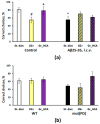Evaluating the Effects of Grain of Isogenic Wheat Lines Differing in the Content of Anthocyanins in Mouse Models of Neurodegenerative Disorders
- PMID: 33353018
- PMCID: PMC7766800
- DOI: 10.3390/nu12123877
Evaluating the Effects of Grain of Isogenic Wheat Lines Differing in the Content of Anthocyanins in Mouse Models of Neurodegenerative Disorders
Abstract
Functional foods enriched with plant polyphenols and anthocyanins in particular attract special attention due to multiple beneficial bioactive properties of the latter. We evaluated the effects of a grain diet rich in anthocyanins in a mouse model of Alzheimer's disease induced by amyloid-beta (Aβ) and a transgenic mouse model of Parkinson's disease (PD) with overexpression of human alpha-synuclein. The mice were kept at a diet that consisted of the wheat grain of near isogenic lines differing in anthocyanin content for five-six months. The anthocyanin-rich diet was safe and possessed positive effects on cognitive function. Anthocyanins prevented deficits in working memory induced by Aβ or a long-term grain mono-diet; they partially reversed episodic memory alterations. Both types of grain diets prolonged memory extinction and rescued its facilitation in the PD model. The dynamics of the extinction in the group fed with the anthocyanin-rich wheat was closer to that in a group of wild-type mice given standard chow. The anthocyanin-rich diet reduced alpha-synuclein accumulation and modulated microglial response in the brain of the transgenic mice including the elevated expression of arginase1 that marks M2 microglia. Thus, anthocyanin-rich wheat is suggested as a promising source of functional nutrition at the early stages of neurodegenerative disorders.
Keywords: Barnes test; T-maze; alpha-synuclein; animal models; bioflavonoids; cognitive; functional food; neurodegeneration; neuroinflammation; passive avoidance.
Conflict of interest statement
The authors declare no conflict of interest. The funders had no role in the design of the study; in the collection, analyses, or interpretation of data; in the writing of the manuscript, or in the decision to publish the results.
Figures






References
MeSH terms
Substances
Grants and funding
LinkOut - more resources
Full Text Sources
Medical

